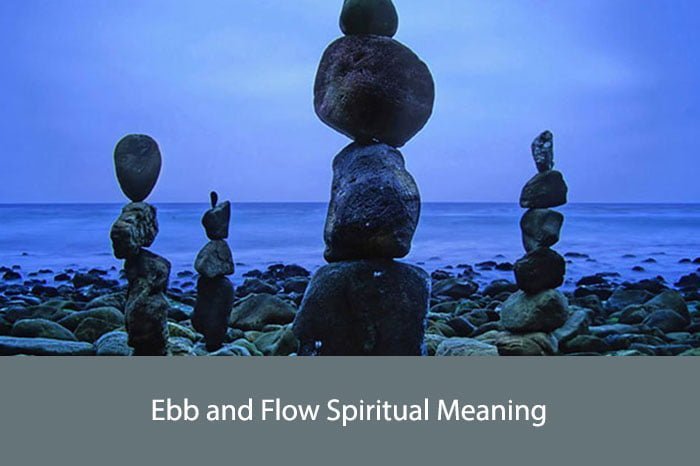Ebb and flow are natural phenomena that occur in the ocean, but they also have spiritual significance. The concept of ebb and flow refers to the cyclical nature of life, where there are times of growth and expansion, followed by periods of contraction and introspection. In spiritual terms, ebb and flow represent the rhythm of life, where we experience highs and lows, successes and failures, and joy and sorrow.
The ebb and flow of spiritual energy is an essential part of our spiritual journey. It is a reminder that life is not always easy, and that we must learn to navigate the ups and downs with grace and resilience. When we are in a state of ebb, we may feel disconnected from our spiritual path, but it is during these times that we have the opportunity to reflect and go deeper within ourselves. Conversely, when we are in a state of flow, we are in alignment with our spiritual purpose and feel a sense of connection and joy.
Understanding the ebb and flow of spiritual energy can help us to navigate our spiritual journey with greater ease and clarity. By recognizing that life is cyclical and that there are times of growth and contraction, we can learn to embrace the natural rhythm of life and trust that everything is happening for our highest good. Whether we are experiencing a period of ebb or flow, we can rest assured that it is all part of the journey, and that we are exactly where we need to be.

Understanding Ebb and Flow
Ebb and flow is a natural cycle that is observed in many aspects of life. In the spiritual context, ebb and flow refers to the cyclical nature of our spiritual journey. It is a process of growth and transformation that involves periods of expansion and contraction, movement and stillness, light and darkness.
During the ebb phase, we may experience a sense of contraction, withdrawal, or even loss. This is a time of introspection, reflection, and letting go. We may feel disconnected from our spiritual practice, our purpose, or our sense of self. It is important to honor this phase and allow ourselves to rest, recharge, and replenish.
The flow phase, on the other hand, is a time of expansion, growth, and abundance. We may feel a renewed sense of energy, inspiration, and purpose. This is a time to take action, express ourselves creatively, and connect with others. It is important to embrace this phase and make the most of the opportunities that come our way.
Understanding the ebb and flow of our spiritual journey can help us navigate the ups and downs of life with greater ease and grace. By recognizing the natural cycles of growth and transformation, we can cultivate a deeper sense of trust, surrender, and resilience. We can also learn to appreciate the beauty and wisdom that can be found in both the light and the darkness.
Spiritual Significance of Ebb and Flow
Connection to Life Cycles
The ebb and flow of tides are a reflection of the natural cycles of life. Just as the tide ebbs and flows, so does life. We experience times of growth and expansion, followed by times of contraction and retreat. The ebb and flow of life is a reminder that nothing stays the same, and change is inevitable. It is during the ebb that we have the opportunity to reflect, recharge, and prepare for the next flow.
Symbolism in Personal Growth
The ebb and flow of life can also be seen as a metaphor for personal growth. Just as the tide flows in and out, so do our emotions, thoughts, and experiences. We may experience times of great joy and abundance, followed by times of struggle and challenge. It is during the ebb that we have the opportunity to reflect on our experiences, learn from our mistakes, and grow as individuals.
Reflection of Universal Balance
The ebb and flow of tides also reflects the balance of the universe. The ebb and flow of the tide is a reminder that everything in the universe is interconnected and in a state of constant change. The ebb and flow of the tide is a reflection of the balance between opposing forces, such as light and dark, yin and yang, and good and evil. It is during the ebb that we have the opportunity to reflect on the balance of the universe and our place within it.
In conclusion, the ebb and flow of tides hold spiritual significance in many aspects of life. It reminds us of the natural cycles of life, the metaphor for personal growth, and the reflection of universal balance.

Ebb and Flow in Different Cultures
Eastern Philosophies
In Eastern philosophies, the concept of ebb and flow is often associated with the yin and yang, which represents the balance of opposing forces in the universe. The yin represents the feminine, passive, and receptive energy, while the yang represents the masculine, active, and creative energy. The ebb and flow of these energies is believed to be necessary for maintaining harmony and balance in the universe.
In Taoism, the ebb and flow of life is seen as a natural process that is necessary for growth and transformation. The Tao Te Ching, one of the most important texts in Taoism, states that “the soft overcomes the hard, and the gentle overcomes the rigid.” This means that by embracing the ebb and flow of life, we can overcome obstacles and achieve our goals.
Western Interpretations
In Western cultures, the ebb and flow of life is often associated with the cycles of nature, such as the changing of the seasons and the tides of the ocean. The ebb and flow of the tides, in particular, has been a symbol of change and transformation throughout history.
In Christianity, the ebb and flow of life is seen as a reflection of the journey of faith. The Bible teaches that there is a time for everything, including a time to be born and a time to die, a time to weep and a time to laugh, a time to mourn and a time to dance. By embracing the ebb and flow of life, Christians can find comfort and hope in the knowledge that there is a purpose to everything.
Overall, the concept of ebb and flow is a universal one that transcends cultural and religious boundaries. Whether we view it through the lens of Eastern philosophy or Western interpretation, the ebb and flow of life is a natural process that we must embrace in order to grow and transform.
Applying Ebb and Flow in Daily Life
Mindfulness Practices
Incorporating mindfulness practices into our daily routine can help us embrace the ebb and flow of life. Mindfulness meditation, for example, can help us become more aware of our thoughts and emotions, and learn to observe them without judgment. This can help us navigate the ups and downs of life with greater ease and equanimity.
Another mindfulness practice is mindful breathing. This involves simply focusing on the sensation of our breath as it enters and leaves our body. When we feel stressed or overwhelmed, taking a few deep, mindful breaths can help us calm down and regain our center.
Embracing Change
Change is a natural part of life, and learning to embrace it can help us navigate the ebb and flow of our spiritual journey. One way to do this is to practice acceptance. This means acknowledging that change is inevitable and learning to let go of our attachment to things staying the same.
Another way to embrace change is to cultivate a growth mindset. This involves seeing challenges and setbacks as opportunities for learning and growth, rather than as failures. When we approach life with a growth mindset, we are better able to adapt to change and see it as an opportunity for transformation.
Overall, incorporating mindfulness practices and embracing change can help us navigate the ebb and flow of our spiritual journey with greater ease and grace.
Conclusion
In conclusion, the ebb and flow spiritual meaning is a complex and multifaceted concept that can be interpreted in many ways. Throughout history, people have looked to the natural world and its cycles to find meaning and guidance in their spiritual lives. The ebb and flow of the tides, the changing of the seasons, and the waxing and waning of the moon all offer powerful metaphors for the ups and downs of our own lives.
As we have explored in this article, the ebb and flow spiritual meaning can be understood as a reminder that life is a series of cycles, and that every low point is followed by a high point. It can also be seen as a call to embrace change and let go of attachments that no longer serve us. Whether we approach it from a religious or a more secular perspective, the ebb and flow spiritual meaning offers a valuable perspective on the challenges and opportunities of life.
Ultimately, the meaning we derive from the ebb and flow of life is deeply personal and subjective. Some may find comfort in the idea that everything is connected and that we are all part of a larger, cosmic cycle. Others may see the ebb and flow as a reminder to stay present and mindful, and to appreciate the beauty of each moment. Whatever our interpretation, the ebb and flow spiritual meaning has the potential to inspire us to live our lives with greater awareness, compassion, and purpose.

Frequently Asked Questions
What is the significance of ebbs and flows in spirituality?
Ebbs and flows refer to the natural cycles of life, where things come and go, rise and fall, and change over time. In spirituality, ebbs and flows represent the ups and downs of our spiritual journey, where we experience periods of growth, stagnation, and transformation. Understanding the significance of ebbs and flows can help us navigate our spiritual journey with greater awareness and acceptance.
How can one apply the concept of ebbs and flows in their spiritual practice?
Applying the concept of ebbs and flows in our spiritual practice involves recognizing the natural cycles of life and embracing them with openness and curiosity. We can use ebbs and flows as an opportunity for growth, learning, and transformation, rather than resisting or denying them. By accepting the ups and downs of our spiritual journey, we can cultivate greater resilience, compassion, and wisdom.
What are some examples of ebbs and flows in a spiritual journey?
Examples of ebbs and flows in a spiritual journey include periods of spiritual awakening, growth, and transformation, as well as times of doubt, confusion, and disillusionment. Other examples include experiences of joy, peace, and connection with the divine, as well as moments of pain, suffering, and loss. Each of these experiences can be seen as an opportunity for learning and growth.
How can ebbs and flows in a relationship be understood from a spiritual perspective?
From a spiritual perspective, ebbs and flows in a relationship can be understood as a natural part of the journey of two individuals coming together to grow and learn. Just as in our spiritual journey, relationships go through cycles of growth, transformation, and challenges. By recognizing the natural cycles of a relationship and embracing them with openness and compassion, we can cultivate deeper connection, intimacy, and understanding.
What is the origin of the phrase ‘ebbs and flows’?
The phrase ‘ebbs and flows’ comes from the natural cycles of the tides, where the water level rises and falls in a rhythmic pattern. The phrase has been used in various contexts to describe the natural cycles of life, including in spirituality.
What are some synonyms for ‘ebbs and flows’ in a spiritual context?
Some synonyms for ‘ebbs and flows’ in a spiritual context include cycles, rhythms, seasons, and phases. Each of these terms represents the natural cycles of life and can be used to describe the ups and downs of our spiritual journey.





